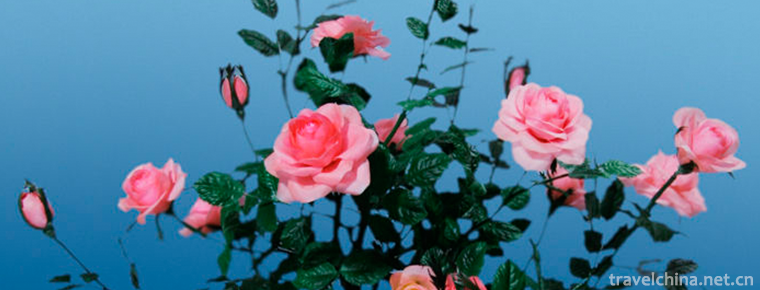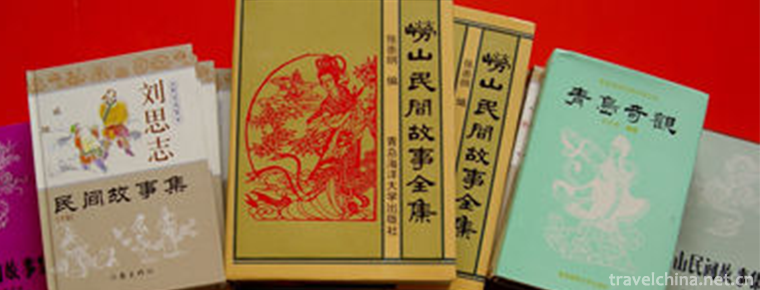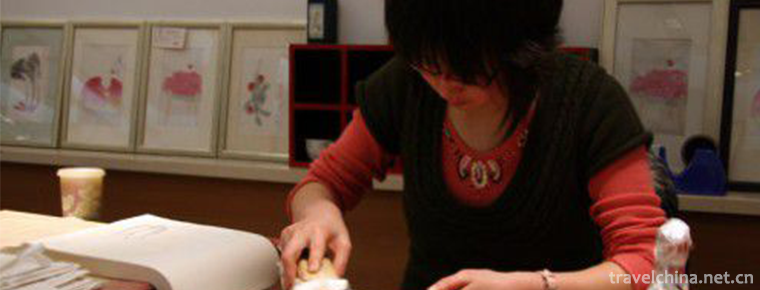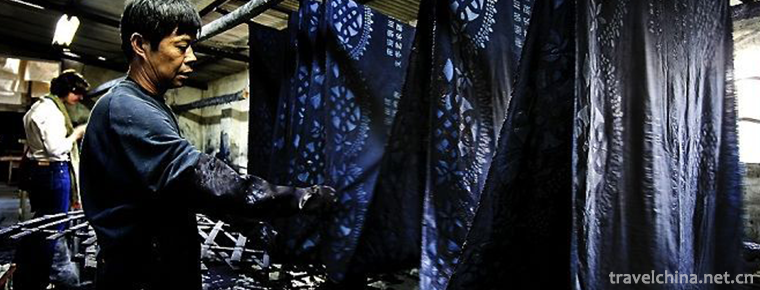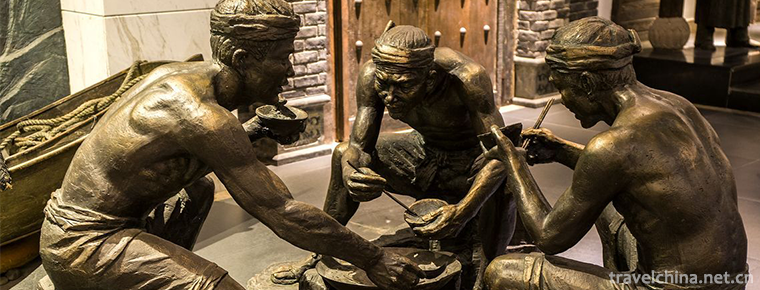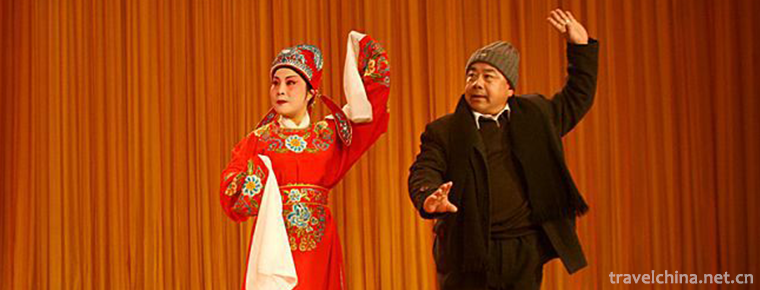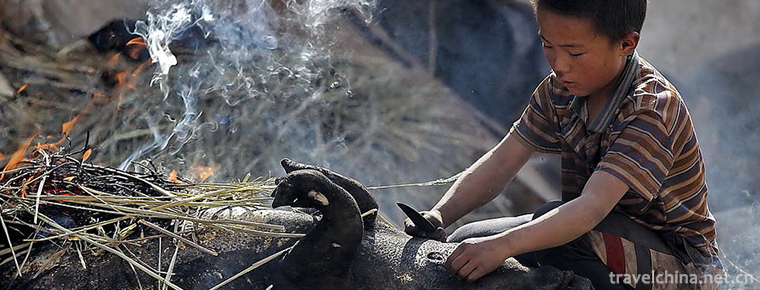Snail rice noodles
Snail jelly powder is a kind of snack rice flour in Liuzhou City, Guangxi Zhuang Autonomous Region. It has the unique flavor of hot, cool, fresh, sour and hot. is the most famous local snack in Liuzhou.
The snail powder is delicious because it has unique soup. The soup is made up of snail, Shannai, star anise, cinnamon, clove, a variety of peppers, and other natural spices and flavors.
In August 20, 2018, "Liuzhou snail powder" was awarded the national geographical indication trademark .
In 2008, the craftsmanship of Liuzhou snail powder was selected as the second batch of intangible cultural heritage in Guangxi Zhuang Autonomous Region.
Chili pepper was introduced into China from the Americas in the late Ming Dynasty. At first, chili pepper was only used as an ornamental crop and medicine. It did not enter Chinese recipes for long. After the strong entry of pepper into China, a considerable dietary revolution was launched. Only when Liuzhou people integrated it into the snail powder and exerted it, did they have the snail powder. Many people who have eaten snail powder question why there is not a single snail in snail powder. It is said that snail soup made of snail meat, pork bone, medicinal materials, natural spices and other folk secret recipes will be discarded after boiling, because its essence is concentrated in the soup .
Snail powder first appeared in the late 1970s. Although it has a short history, snail powder and rice powder have a long history in Liuzhou. Liu Wen, who has been engaged in cultural relics and Archaeology for more than 40 years in Liuzhou, believes that from a small point of view, the historical and cultural development track of Liuzhou is a history of collecting food snails.
More than 40 years ago, Chinese archaeologists discovered a large number of snail shell deposits at Bailian Cave and Dalongtan carp mouth sites. "About 20,000 years ago, the Liujiang people living in Bailian Cave began to catch snails for food and learn to use fire. Now there are still remains of the primitive people who burned snails in Bailian Cave site." Jiang Jinyuan, director of the cave Museum of Bailian cave, Liuzhou, said.
There are different opinions on the origin of snail-worm powder, which can not be verified, but almost every legend has a strong "snail-worm complex" and "rice-powder complex". In 2008, Liuzhou snail powder handicraft craftsmanship successfully declared the second batch of intangible cultural heritage list of the autonomous region. Huang Xiaoping, who was in charge of the application work at that time, wrote in the declaration document: "The snail powder made by combining rice flour and snail grubs is a great creation of the folk in Liuzhou, and its unique traditional craftsmanship is precious in Liuzhou. The intangible cultural heritage.
Making method
1. cut the lean meat on the pig bone and cut the spine directly.
2. field snail shell in the clear water for 1 hours to remove sediment and soil flavor, and then wash it again.
3. Cut the material into silk and dice, pour some oil into the pot to fry the rotten bamboo slices (the oil should be hot when frying the rotten bamboo slices, but it should be fried away from the fire, or it will be burnt). Then pour the remaining oil of the fried rotten bamboo into chili powder to make chili oil (pay attention to the remaining temperature of the fried rotten bamboo, do not add fire).
4. * put the pig bones into the pot and add the soup. Add a tablespoon of rice wine in the water. Stir fry the sauerkraut and sour beans in the pan, add a little oil, but do not put salt.
5. black fungus and pork (cut lean meat) in a pot, stir fry and add a little salt.
6. Put oil in the pan, add garlic and ginger slices, stir-fry snails, add a tablespoon of salt and half a tablespoon of spices, stir-fry for 2 minutes, then add half a bowl of water, boil and put them in the bone soup to boil together.
7. Cook the soup with snail meat for 1 hour, and then put the chili oil in the pot (if you don't like spicy food, don't add it).
8. Boil half a pot of water, put salt in the water (stirring evenly, tasting salty). When boiling water, blanch the rice flour in the water, then pick it up, add the prepared ingredients, and finally add the screw soup and snail powder to finish .
Hints
1. if you don't have snail, you can use other types of snails at will.
2. the most important thing is the bottom of the soup. The taste of the soup must be adjusted to .
3. the round rice flour prepared for making snail powder is not the usual rice flour, but the coarser .
4. accessories can be added. Pickled bamboo shoots, sauerkraut, fried peanuts, dried radish and chopped green onion can be added to the snail powder.
5. Dry-cut flour made of aged rice with a cross-sectional diameter of about 3 mm should be immersed in water for 1 hour in advance, and cold water should be used. Otherwise, the flour will break after cooking and will not have elasticity .
6. To make the snail powder more delicious, the snail must live and soak in the water for 2 days. A piece of iron is put into the water to promote the sludge vomiting of the snail, which can not only inhibit the schistosomiasis parasitic in the snail body, but also ensure the sweetness of the meat of the snail.
Snail jelly powder is rich in carbohydrates, colloid, cephalin, cellulose, lecithin, protein, carotene, various vitamins, iron, calcium, phosphorus and other nutrients, which can not only satisfy the appetite, but also maintain health.










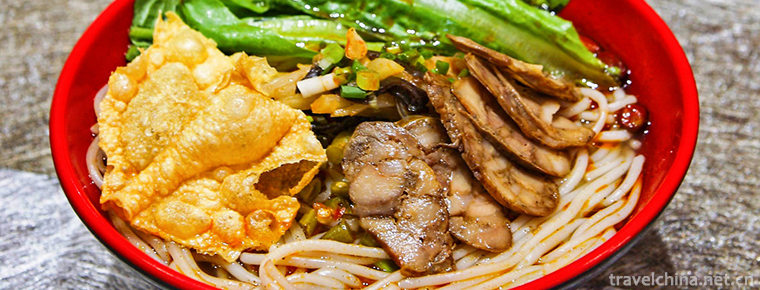
-
Olympic Rowing Canoeing Park
Beijing Olympic Water Park, also known as Shunyi Water Park, is located in Chaobai River, Mapo Township, Shunyi District, Beijing. Its building area is 31850 square meters, and the number of seats is .
Views: 148 Time 2019-01-02 -
Yinghu Scenic Area
Yinghu, a national AAAA-level tourist area, is located 16 kilometers southwest of Ankang City, Shaanxi Province. The total area is 102.8 square kilometers, including 77 square kilometers.
Views: 163 Time 2019-03-05 -
Beijing silk flower
Beijing silk flower, one of the traditional handicraft products in Beijing, also known as "Beijing flower", originated in Shenmuchang Street outside Chongwenmen in Ming Dynasty.
Views: 179 Time 2019-04-04 -
Buyi Folk Songs
Bouyei folk songs have special features, such as ancient songs, narrative songs, love songs, wine songs and labor songs; solo, duet, chorus and duet in form; tunes are divided into major and minor. Ev.
Views: 143 Time 2019-04-04 -
Laoshan Folk Stories
Laoshan folk tales, commonly known as Lagua, are oral literature created by the local people of Laoshan Mountain in Shandong Province for thousands of years. There were few written records before libe.
Views: 115 Time 2019-05-11 -
Wood Watermarking Techniques
Wooden watermarking is mainly made by such basic technological procedures as hook (sub-plate), engraving (plate-making), printing (printing) and special techniques as engraving, picking and dusting..
Views: 155 Time 2019-06-06 -
Printing and Dyeing Techniques of Nantong Blue Printing Cloth
Nantong Blue Printing and Dyeing Technology, one of the local traditional printing and dyeing techniques in Nantong City, Jiangsu Province, is one of the national intangible cultural heritage..
Views: 157 Time 2019-06-07 -
Copper Carving Skills
Hangzhou bronze sculpture is the continuation of ancient bronze manufacture. It developed greatly in Wuyue and Southern Song Dynasty. After Tongzhi in Qing Dynasty, Hangzhou bronze sculpture represent.
Views: 160 Time 2019-06-21 -
Yihuang Opera
Yihuang Opera, formerly known as Yihuang Ban and Yihuang Diao, is one of the national intangible cultural heritage in Yihuang, Nancheng, Nanfeng and Guangchang counties of Jiangxi Province, as well as.
Views: 333 Time 2019-07-12 -
Year of the Yi Nationality
In the year of the Yi people, the Yi language is called "Kusi", "Ku" is the year of the Yi people and "Si" is the new year. It means "New Year". It is a traditi.
Views: 210 Time 2019-07-12 -
Da Zang Temple
Located in the north of malkang County, dazang temple is about 500 kilometers away from Chengdu City and is located in the deep mountains above 3000 meters above sea level. .
Views: 242 Time 2020-11-07 -
Meishan mineral resources
There are 25 kinds of minerals in Meishan, mainly including coal, natural gas, iron, copper, lead, zinc, manganese, placer gold, glauberite, gypsum, bentonite, phosphorus, dolomite, cement limestone, magnesite, granite for facing, vein quartz, crystal, quartz sandstone,.
Views: 261 Time 2020-12-18


